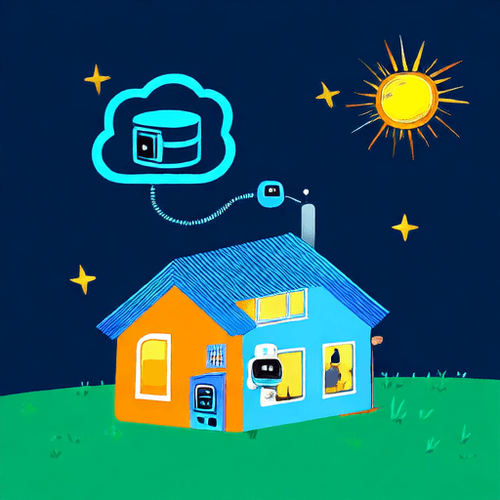Secure Remote Access to Home Assistant with Tailscale

NGC 224
DIY Smart Home Creator
Why Secure Remote Access is Crucial for Home Assistant
Having remote access to your Home Assistant instance is essential for managing your smart home on the go, receiving critical alerts, and ensuring everything is running smoothly even when you're away. However, exposing your Home Assistant directly to the internet via port forwarding is fraught with security risks. It makes your instance a potential target for malicious actors looking to exploit vulnerabilities.
While Home Assistant Cloud offers a convenient, secure remote access solution, it's a paid service. Traditional VPNs like OpenVPN or WireGuard provide security but often require significant technical expertise to set up, configure firewall rules, and manage certificates or keys.
Enter Tailscale – a modern VPN service built on the WireGuard protocol that offers a much simpler way to create a secure, encrypted network connecting only the devices you authorize. It works behind NAT, firewalls, and makes peer-to-peer connections whenever possible. For Home Assistant users, Tailscale provides a straightforward and highly secure method for remote access without opening ports on your router.
What is Tailscale?
Tailscale creates a secure mesh network among your devices, wherever they are. Each device on your Tailscale network gets a unique, stable IP address within the 100.x.y.z range. Communication between devices on your Tailscale network is encrypted end-to-end.
Key benefits for Home Assistant users:
- Ease of Setup: Install the add-on, log in, and you're connected. No port forwarding needed.
- Enhanced Security: Uses WireGuard, modern cryptography, and a zero-trust security model. Only authorized devices can join your network.
- Works Anywhere: Connects devices regardless of their physical location or network (home, office, mobile data).
- Direct Connections: Attempts peer-to-peer connections, reducing latency and reliance on central servers for data transfer.
Setting Up Tailscale on Home Assistant
Setting up Tailscale on Home Assistant is primarily done through the official Tailscale add-on available in the Home Assistant Add-on store.
Prerequisites:
- A running Home Assistant instance (any installation method that supports add-ons, like Home Assistant OS, Supervised, or Container with add-on support).
- A Tailscale account (the free tier is sufficient for personal use and covers up to 100 devices). Sign up at tailscale.com.
Installation and Configuration Steps:
-
Navigate to Add-ons: In your Home Assistant UI, go to
Settings>Add-ons. -
Open Add-on Store: Click on the
Add-on Storebutton in the bottom right corner. -
Search for Tailscale: Search for "Tailscale" and select the official add-on.

-
Install the Add-on: Click the
Installbutton. Wait for the installation to complete. -
Configure the Add-on: Before starting, go to the
Configurationtab. Most users won't need to change default options unless they have specific requirements like enabling subnet routing (which is advanced and often not needed just for accessing HA).Ensure
enable_exit_nodeisfalseunless you specifically want your HA instance to act as an exit node for other Tailscale devices to route internet traffic through (this requires enabling IP forwarding on the host system and is outside the scope of basic remote access). -
Start the Add-on: Go to the
Infotab and click theStartbutton. Optionally, enableStart on bootandWatchdogfor reliability. -
Check Logs for Authentication URL: Go to the
Logstab. Look for a line containing a URL that starts withhttps://login.tailscale.com/a/. This is the authentication URL.
-
Authenticate Home Assistant: Copy the full URL from the logs and paste it into a web browser on any device where you are logged into your Tailscale account. Click the link to authorize your Home Assistant instance to join your Tailscale network.

Alternatively, you can generate a reusable auth key from the Tailscale admin panel (https://login.tailscale.com/admin/settings/authkeys), configure it in the add-on's configuration tab under
auth_key, and restart the add-on. This is useful for headless setups or automated deployments. -
Verify Connection: Once authorized, the Home Assistant instance should appear as a new device in your Tailscale admin panel (https://login.tailscale.com/admin/devices). It will have a name (often based on its hostname) and a Tailscale IP address.

Accessing Home Assistant Remotely
Now that Home Assistant is on your Tailscale network, you need to install the Tailscale client on the device(s) you want to use for remote access (smartphone, tablet, laptop, etc.).
Steps to Access:
-
Install Tailscale Client: Download and install the Tailscale client for your operating system or mobile device from the Tailscale website (tailscale.com/download) or app stores.

-
Log In to Client: Open the Tailscale client app and log in using the same Tailscale account you used to authorize Home Assistant.

-
Connect via Tailscale IP: Once the client shows it's connected to your Tailscale network, you can access your Home Assistant instance using its Tailscale IP address followed by the Home Assistant port (usually 8123).
For example, if your Home Assistant's Tailscale IP is
100.10.10.10, you would access it by going tohttps://100.10.10.10:8123in your web browser or the Home Assistant Companion App.
Using MagicDNS for Easier Access
Tailscale's MagicDNS feature assigns human-readable names to devices on your network (e.g., my-hass-instance). To enable this:
- Go to the Tailscale admin panel (https://login.tailscale.com/admin/dns).
- Enable
MagicDNS. - Enable
Advertise exit nodes and routes(optional, if you configure those).
Once enabled, you can access Home Assistant using its MagicDNS name (e.g., https://my-hass-instance:8123) from any device also connected to your Tailscale network, without needing to remember the IP address.
Best Practices for Reliability and Security
-
Keep Software Updated: Regularly update your Home Assistant instance and the Tailscale add-on. Also, keep the Tailscale client apps on your accessing devices updated. This ensures you have the latest security patches and features.
-
Strong Authentication: Secure your Tailscale account with a strong password and enable Two-Factor Authentication (2FA) if possible. Your Tailscale account is the key to your private network.
-
Manage Devices: Periodically review the list of devices in your Tailscale admin panel. Remove any old or unrecognized devices.
-
Use Access Control Lists (ACLs): For more advanced security, configure ACLs in your Tailscale admin panel (https://login.tailscale.com/admin/acls). ACLs allow you to define which devices can connect to which other devices on your Tailscale network. For example, you could restrict access to your Home Assistant only from your specific mobile devices.
-
Avoid Port Forwarding: If you are using Tailscale for remote access, ensure you have closed any ports on your router that might have previously forwarded traffic to Home Assistant (like port 8123). Tailscale provides a secure tunnel, making direct internet exposure unnecessary and unsafe.
-
Private Keys and Device Renaming: In the Tailscale admin console, you can rename devices to be more descriptive (e.g., "Home Assistant Server"). You can also manage device keys and revoke them if a device is compromised or no longer needed.
Tailscale vs. Other Remote Access Methods
- vs. Port Forwarding: Tailscale is significantly more secure as it doesn't expose your Home Assistant directly to the public internet.
- vs. Traditional VPN (OpenVPN/WireGuard Server): Tailscale is much simpler to set up and manage, especially for users who aren't networking experts. It handles NAT traversal automatically.
- vs. Home Assistant Cloud: HA Cloud offers tight integration, including Alexa/Google Assistant voice control and webhooks, which Tailscale doesn't provide directly. However, Tailscale is free for personal use (up to 100 devices) and offers robust network access to *all* services on the joined device, not just Home Assistant's web UI.
Tailscale is an excellent choice for users who prioritize ease of use and security for remote access and don't require the specific voice assistant/webhook features of Home Assistant Cloud.
Conclusion
Securing remote access to your Home Assistant instance is not an option, it's a necessity. Tailscale provides a modern, user-friendly, and highly secure way to achieve this without the complexities and risks associated with traditional methods. By following the steps outlined above, you can easily set up a private, encrypted network to safely manage your smart home from anywhere in the world, enhancing both the reliability and security of your Home Assistant ecosystem.

NGC 224
Author bio: DIY Smart Home Creator
